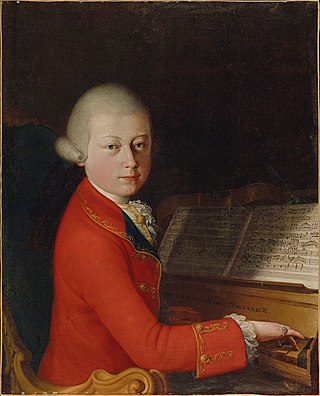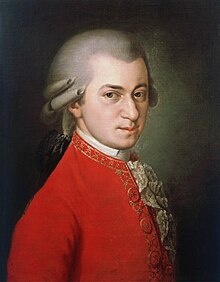
The Köchel catalogue is a formerly chronological catalogue of compositions by Wolfgang Amadeus Mozart, originally created by Ludwig Ritter von Köchel, in which the entries are abbreviated K. or KV. Its numbers reflect the ongoing task of compiling the chronology of Mozart's works, and provide a shorthand reference to the compositions.
The Adagio and Fugue in C minor, K. 546, is a composition by Wolfgang Amadeus Mozart for strings. Mozart entered it into his own work catalogue on 26 June 1788 in Vienna as "A short Adagio for two violins, viola and bass, for a fugue which I wrote some time ago for two Pianos". The fugue in question was the two piano fugue in C minor, K. 426, written in December 1783.

The Symphony No. 4 in D major, K. 19, by Wolfgang Amadeus Mozart was composed in London during the Mozart family's Grand Tour of Europe in 1765, when Mozart was nine years old.

Symphony No. 34 in C major, K. 338, was written by Wolfgang Amadeus Mozart in 1780, and completed on 29 August that year.

The Symphony No. 26 in E♭ major, K. 184/161a, was written by Wolfgang Amadeus Mozart and completed on March 30, 1773, one month after he returned from his third Italian tour.

Symphony No. 6 in F major, K. 43, was composed by Wolfgang Amadeus Mozart in 1767. According to Alfred Einstein in his 1937 revision of the Köchel catalogue, the symphony was probably begun in Vienna and completed in Olomouc, a Moravian city to which the Mozart family fled to escape a Viennese smallpox epidemic; see Mozart and smallpox.

Symphony No. 7 in D major, K. 45, by Wolfgang Amadeus Mozart, was completed in Vienna in January 1768 after the family's return from a visit to Olomouc and Brno in Moravia. The symphony is in four movements. Its first performance was probably at a private concert. The symphony was reworked to become the overture to Mozart's opera, La finta semplice, K. 51, composed and performed later that year, and the overture itself was subsequently adapted further to create a new symphony, known in the Köchel 1964 (K6) catalogue as K. 46a. The autograph of the score is preserved in the Berlin State Library.

Symphony No. 9 in C major, K. 73/75a, by Wolfgang Amadeus Mozart, has an uncertain provenance. The most likely date of its composition appears to be late 1769 or early 1770 during Mozart's first Italian journey, although some authorities have dated it "probably not before early summer 1772". It may have been started in Salzburg, before the first Italian journey began, and completed during the trip.

This list of Mozart symphonies of spurious or doubtful authenticity contains 39 symphonic works whose initial attribution to Wolfgang Amadeus Mozart has subsequently been proved spurious, or is the subject of continuing doubt. The number of symphonies actually written by Mozart is imprecisely known; of the 41 formally numbered, three are established as by other composers and another, No. 11, is considered by scholars to be of uncertain authenticity. Outside the accepted sequence 1–41, however, there are around twenty other genuine Mozart symphonies, and beyond these, a larger number of problematic works which have not been authenticated as Mozart's. Some of these may be genuine; dubious works are often treated as authentic by the compilers of collected editions—eight are in the main body of the 1991 Neue Mozart-Ausgabe, and another two are included in the supplementary 2000 volume of works of doubtful authenticity. Some, however, have long been accepted as the works of other composers, who in many instances have been positively identified.

The Missa brevis in G major, K. 140, K3 Anh. 235d, K6 Anh. C 1.12, was probably composed by Wolfgang Amadeus Mozart shortly after returning to Salzburg, in March 1773, from his third trip to Italy.

The Symphony in G major "Old Lambach", K. Anh. 221/45a, was probably written by Wolfgang Amadeus Mozart during 1766 in The Hague and revised in 1767. Both versions – the original and the revision – have survived.
The Symphony "No. 43" in F major, K. 76/42a, was probably written by Wolfgang Amadeus Mozart.
The Symphony in B♭ major "No. 55", K. Anh. 214/45b, was probably written by Wolfgang Amadeus Mozart in early 1768 in Salzburg.
The Symphony in C major "No. 46", K. 96/111b, was probably written by Wolfgang Amadeus Mozart in 1771 in Milan.
The Symphony in D major "No. 45", K. 95/73n, was probably written by Wolfgang Amadeus Mozart in 1770 in Rome.
The Symphony in D major "No. 47", K. 97/73m, was probably written by Wolfgang Amadeus Mozart in 1770 in Rome.
The Symphony in F major "No. 56", K. 98/Anh.C 11.04, was once thought to have been written by Wolfgang Amadeus Mozart, but today is regarded as spurious. As of 2009, it is the only one of Mozart's symphonies published in the Alte Mozart-Ausgabe that has never been recorded. It is not included in the Neue Mozart-Ausgabe.
The Symphony in D major "No. 44", K. 81/73l, may have been written by Wolfgang Amadeus Mozart in 1770 in Rome, although it has sometimes also been attributed to his father Leopold Mozart. It is now also catalogued as Eisen D 14 in Cliff Eisen's catalogue of Leopold Mozart's symphonies.
The Symphony in B♭ major "No. 54", K. Anh. 216/74g/Anh.C 11.03, may have been written by Wolfgang Amadeus Mozart in 1771, in Salzburg.
The lost Symphony in C major, K. Anh. 222/19b, was probably written by Wolfgang Amadeus Mozart in early 1765 in London. It is one of the twelve symphonies that Ludwig von Köchel only knew by its incipit in the Breitkopf & Härtel manuscript catalogue, which listed it as one of six symphonies (Nos. 65–70) sourced from Luigi Gatti (1740–1817), Court Kapellmeister in Salzburg from around 1782:






